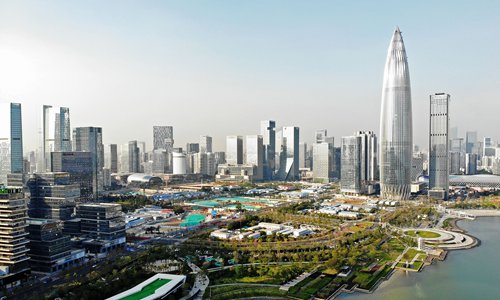HOME >> CHINA
Experts laud knowledge-based industry approach for city’s achievements
Source:Xinhua Published: 2019/5/29 16:53:40

An aerial view of the Shenzhen Bay Super Headquarters Base, a newly developing area in Nanshan district, Shenzhen, South China's Guangdong Province Photo: VCG
The city of Shenzhen, which was originally a small fishing village, has realized rapid development to become the Silicon Valley of China thanks to a knowledge-based industry approach, according to an African expert.
Aloysius Mosha, professor and dean at the faculty of the Built Environment, Ba Isago University in Botswana, said that Shenzhen attained the status following its decision to disregard the "business as usual" management approach.
"The city is a clear blueprint of how to handle fast urbanization through the adoption of innovative financing strategies," Mosha said on Monday evening during the launch of the book The Story of Shenzhen, its Economic, Social and Environmental Transformation, published by UN Habitat.
Mosha noted that the city, situated in southeastern China, has become famous for using traditional and innovative strategies to finance infrastructure development.
The scholar, who is one of the co-authors of the book that was written early this year, observed that the city has gone beyond the traditional funding streams and ventured into innovative strategies, such as land value capture, issuance of municipal bonds, foreign direct investments, project finance, public private partnerships, special purpose vehicles and tax incentive financing.
The don noted that the city has moved from normal city financing to innovative financing and encourages and finances entrepreneurs interested in industrial development and also provides many incentives to woo local and international investors.
"Shenzhen has proved that good governance can be achieved through appropriate policies, regular reforms and innovative approaches," he noted.
He added that the city has proved that even though rapid urbanization is inevitable, its consequences and adverse impacts can be managed through integrated and sustainable urban planning.
"Looking at the achievement, for this four-decade-old miracle to continue, the old Chinese practice of long-term thinking needs to be practiced," Maimunah Mohd Sharif, executive director of the United Nations Human Settlement Program (UN Habitat), said in her foreword statement in the book.
She said that Shenzhen is truly a remarkable success story, and existing cities, upcoming cities and special economic zones can learn from its experience.
Sharif observed that the city's remarkable economic and social development has been built on the high-tech, manufacturing and service industries.
The UN official said that sustainable development must be pursued in order to address current global challenges of rising poverty, social inequality, environmental degradation and climate change in the rapidly urbanizing world.
Test case
Lawrence Scott, one of the authors of a chapter in the book, noted that from his study, Shenzhen is turning out to be China's center of modernization due to its advancement in science and technology.
"The city shows that the future belongs to complex high technological responses to its challenges," he noted.
Scott said that the city is a test case for how the challenge of governance or of civil society will be handled in the years to come.
He observed that China's State-owned Assets Supervision and Administration Commission plays a double role in both overseeing and facilitating state-owned enterprise projects.
"This role is attributed to the apparently magical quality of success and harmony within firms rather than market pressure," he added.
Chen Jinhai, a deputy executive director general at the Shenzhen Association for International Culture Exchanges, said that Shenzhen is building, in accordance with the Chinese government's decisions and deployments, the Guangdong-Hong Kong-Macao Greater Bay Area, a global regional cultural central city, and an international cultural, innovative and creative pioneer city.
Chen said the city is also taking the lead in the nation to steadfastly deepen reform and expand opening-up.
"I believe that many cities, towns and special economic zones in other countries can be inspired by Shenzhen's experience in urban development," he added.
Chen noted that the book will contribute to the body of knowledge on urban development, and benefit city leaders, urban planners, academics and economists.
The authors noted that Shenzhen's economy is driven by knowledge-based industries and is ranked third highest among 659 Chinese cities. According to the 2017 Global Financial Centres Index, it is the 22nd most competitive financial center in the world.
It covers an area of 1,997 square kilometers, with a population of more than 20 million, whose average age is 33.
Shenzhen has achieved tremendous economic and social development within the last four decades since the establishment of Shenzhen Special Economic Zone in 1980.
Also, Shenzhen is an important window for China to show its great achievements to the world and for the international community to observe China's reform and opening-up.
Newspaper headline: Shenzhen’s success story
Posted in: IN-DEPTH